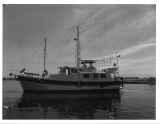I have been following the discussions about stabilization methods. seems like everyone has a favorite and they all have advantages and disadvantages. I have not seen mention of water filled ballast tanks. I know that they are mentioned briefly in Beebe's book. Although if i remember correctly the mention is made by a revising author not Beebe himself. Also if i remember correctly, they work well and are move common of fishing vessels less common on yachts.
So why is this? seems like there would be some very difficult math to get it right but when you did it would be basically maintenance free. non parasitic on the propulsion and electric system. Am i missing something? Can anyone fill in my knowledge gaps?
For anyone who is unfamiliar, as i understand, these are essentially water filled tubes with baffles that are secured above a boat's center of gravity. As the boat begins to roll they baffles hold the water on the on the high side of the boat long enough to suppress the roll.
So why is this? seems like there would be some very difficult math to get it right but when you did it would be basically maintenance free. non parasitic on the propulsion and electric system. Am i missing something? Can anyone fill in my knowledge gaps?
For anyone who is unfamiliar, as i understand, these are essentially water filled tubes with baffles that are secured above a boat's center of gravity. As the boat begins to roll they baffles hold the water on the on the high side of the boat long enough to suppress the roll.




